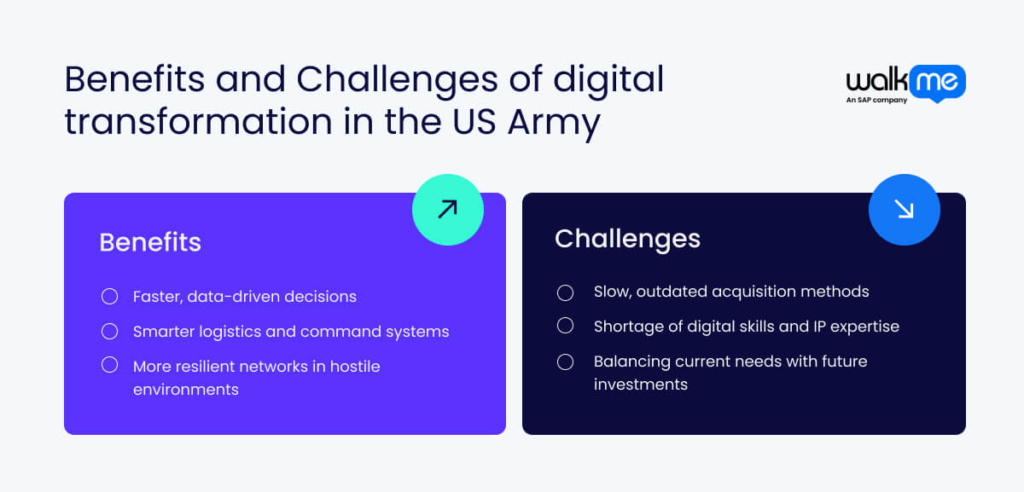Army digital transformation has been underway longer than you might think.
Throughout history, the U.S. Army has embraced emerging technologies to gain an operational edge. It used early battlefield computers in Vietnam and GPS-guided artillery during the Gulf War, long before these tools became mainstream.
Today, digital transformation in the Army focuses on artificial intelligence (AI) and intelligent automation designed to process battlefield data, predict threats, and assist soldiers in real-time.
This article explores the digital transformation unfolding within the U.S. Army, examining how advanced technologies are reshaping operations, decision-making, and strategy while addressing the complex challenges of modernization.
What is digital transformation in the US Army?
Digital transformation in the U.S. Army is the structured overhaul of how it operates, fights, and makes decisions, driven by technology adoption.
It involves integrating AI, cloud transformation, data analytics, and autonomous systems into missions, logistics, and training. For example, Project Convergence, led by the Army Futures Command, connects sensors, weapons, and troops across domains using real-time data. This reduces decision and response times from minutes to seconds.
Multi-cloud infrastructure now supports secure battlefield communications, while AI tools help predict equipment failure before it happens, cutting downtime. Digital training platforms like IVAS (Integrated Visual Augmentation System) provide soldiers with real-time battlefield overlays and immersive simulations. These tools aren’t layered onto old systems but are set to replace them.
The U.S. Army’s ultimate goal is faster, smarter decisions in complex environments. These efforts aim to embed digital transformation into core policy, turning data into immediate action. The result is a force that’s more agile, adaptive, and prepared for high-tech warfare.
What is Army 2030?
Army 2030 is the U.S. Army’s strategic plan to fully integrate advanced technologies, streamline operations across all domains, and embed innovation into every level of force design and decision-making.
It mandates resilient clouds, encrypted data fabrics, and unified control across air, land, sea, space, and cyber.
Pilot projects have already showcased robotic resupply convoys that navigate rugged terrain without human oversight. Augmented-reality headsets can now recreate scenarios, sharpening decision skills before deployment.
By 2030, the aim is for every internal department and organization within the U.S. Army to use digital threads from command posts to front-line squads.
What are the key pillars of digital transformation in the US Army?

Understanding the foundations of the Army’s digital shift is essential to grasp how it plans to operate and outpace rivals in a world defined by speed, data, and connected systems.
These core elements reveal how the Army is transitioning from legacy applications to modernized systems.
Let’s take a closer look at the key pillars of digital transformation in the US Army:
Network convergence and resilience
Modern Army operations depend on merging communications, intelligence, and sensor networks into a single secure infrastructure. Resilience ensures these systems can’t fail under attack. Programs like the Integrated Tactical Network ensure units stay connected even in degraded environments. They use satellite redundancy, secure mesh links, and dynamic rerouting protocols to maintain command and control under extreme operational stress.
Software-defined capabilities
Instead of relying on hardware upgrades, the Army is shifting toward systems that can be reprogrammed instantly. Radios, for instance, can now adapt to new waveforms via software patches. This ensures compatibility across allied forces without replacing physical units. The Electronic Warfare Planning and Management Tool (EWPMT) is another example. It allows soldiers to reconfigure jamming frequencies and settings through software, making the electromagnetic battlefield more adaptable and responsive.
Data as a strategic asset
Data is no longer seen as background information; it’s now used as a weapon, a shield, and a guide. Army units use real-time sensor feeds, drone imagery, and logistics databases to make precision decisions. Platforms like Vantage aggregate vast data points into dashboards that inform readiness, maintenance, and deployment. Leadership treats this information as a core resource for forecasting enemy moves, allocating supplies, and identifying weak spots before they’re exploited.
AI integration & automation
AI supports faster decisions, fewer errors, and more autonomy at every level. In forward environments, systems like Project Maven help process drone footage, identifying threats without human input. AI also supports cyber defense, spotting anomalies and blocking intrusions before they spread. Logistics chains even use predictive analytics models to schedule repairs before breakdowns occur. These applications reduce delays and allow soldiers to focus on tasks machines can’t perform.
Modular and interoperable systems
Legacy systems often couldn’t “talk” to each other in the past, but that’s changing. The Army is designing platforms like TITAN (Tactical Intelligence Targeting Access Node) to integrate with various other tools such as radars, satellites, and command systems, regardless of vendor. Modularity means upgrades happen by swapping out components, not replacing entire systems. This approach reduces cost, shortens deployment times, and ensures emerging tech can quickly integrate into the force without disruption.
What strategies are enabling the US Army to accelerate transformation?
The Army is accelerating digital transformation because future conflicts won’t wait for traditional timelines. Understanding this urgency is essential as it reflects a shift from slow adaptation to rapid, informed evolution.
Let’s take a closer look at the strategies the US Army is using to accelerate digital transformation:
Reforming acquisition for agility
The Army is changing how it acquires new tech, making the process quicker and more flexible. They can test new technologies faster instead of waiting years to deploy new digital tools. For example, they can try out new wearable sensors for soldiers and ensure they work before fully rolling them out.
Building IP licensing expertise
Efforts are being made to collaborate with companies on tech development while maintaining control of important ideas. Mastering intellectual property (IP) licensing means the Army can continue using technology while working with businesses to improve it, especially in crucial areas such as AI.
Investing in digital talent
More tech experts, including engineers and computer specialists, are being brought in to build and manage digital tools like apps and software for soldiers. For instance, the Software Factory in Austin trains soldiers to develop secure software independently, reducing the need for external assistance.
Engaging industry early
Instead of waiting for tech to be fully completed, the Army works with companies right from the start. This ensures new tools are ready for real military challenges. Programs like xTechSearch connect startups with the Army to ensure technology is useful in the field before it gets too advanced.
Modernizing cyber defenses
To protect against hackers, the Army is upgrading its cyber defense systems. It utilizes advanced instruments that can detect and neutralize threats in real-time. With new strategies like zero-trust security, the Army ensures that all its devices and networks stay safe, even when digital threats are everywhere.

What are the benefits of digital transformation in the US Army?
Now that you understand what digital transformation in the U.S. Army is and why it matters, along with its key pillars and strategies, the next step is to explore its benefits. This will provide a holistic view of how the Army is preparing for the future.
Let’s take a closer look at the benefits of digital transformation in the US Army:
Faster, data-driven decisions
The Army’s push for digital transformation means decisions are made faster, based on real-time data. Instead of waiting for reports to trickle in, commanders can access crucial intelligence instantly, allowing them to pivot strategies as conditions change. Speed is critical on the battlefield, and this shift gives the Army a decisive edge.
Smarter logistics and command systems
Digital transformation is making Army logistics and command systems more responsive and efficient. Real-time data helps commanders track resources and personnel, ensuring that assets are deployed where needed most. This shift means fewer delays and faster reactions, improving mission outcomes.
More resilient networks in hostile environments
In a digital age, the Army can’t afford vulnerable communications. Digital transformation is strengthening its networks to withstand cyberattacks and electronic warfare. These highly resilient systems ensure that vital data keeps flowing even in the most contested environments. This fuels continuous operations and command-and-control, no matter the threat.
What are the challenges of digital transformation in the US Army?
Modernizing a force as vast and complex as the U.S. Army is never linear. The real test lies in aligning new tools with Army principles, infrastructure, and a workforce ready to operate at digital speed.
Let’s take a closer look at the challenges of digital transformation in the US Army:
Slow, outdated acquisition methods
The Army still uses legacy systems to acquire new technology, which takes too long and is inefficient. It can take years to approve and build the tools soldiers need now. While other countries move fast with off-the-shelf tech, delays like these make it harder for the U.S. Army to stay ahead in combat or otherwise.
Shortage of digital skills and IP expertise
Modern tools need people who know how to code, fix networks, and build software. But the Army doesn’t have enough dedicated technology personnel. It also struggles to protect the IP of its ideas when working with outside companies, which means it sometimes loses control of the technology it depends on.
Balancing current needs with future investments
The Army must sustain operational readiness while funding long-term innovation. This is a strategic tension rooted in finite resources. Overcommitting to future systems risks under-equipping ground troops, while prioritizing current needs can delay critical modernization.
What’s next for Army digital transformation?
Army 2030 is being rolled out across different units, and what’s being learned is already changing how the Army trains and uses technology.
Project Convergence has shown where old systems slow things down, especially when different teams try to share data or use new tools jointly.
These lessons are shaping Army 2040, which will rely less on gear and more on fast, secure software. Future soldiers will win by moving information quickly, making more rapid decisions, and staying connected, even in tough places. This allows them to act as one, no matter where or what threat they face.
The U.S. Army’s digital transformation redefines how warfare will be fought, won, and understood in the years to come.
The question remains, will the Army’s technology-driven future be enough to outsmart an increasingly unpredictable world?
FAQs
The Army uses AI to analyze battlefield data in real-time, helping soldiers make quicker, more accurate decisions. AI identifies threats, predicts equipment failures, and enhances situational awareness, instantly ensuring commanders have the information they need.
Cloud migration enables the Army to centralize data across operations, allowing faster, more secure communication. It supports real-time collaboration, ensuring that critical information flows logically between units.
The Army collaborates with tech companies through initiatives like xTechSearch, accelerating the development of new technologies. Working with private sector innovators means the Army ensures its systems stay modern, adapting quickly to new tech that enriches its core capabilities.

